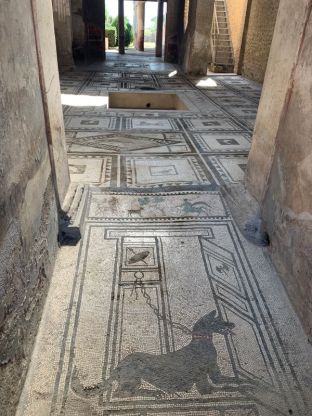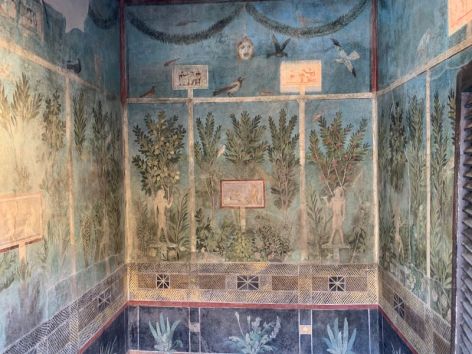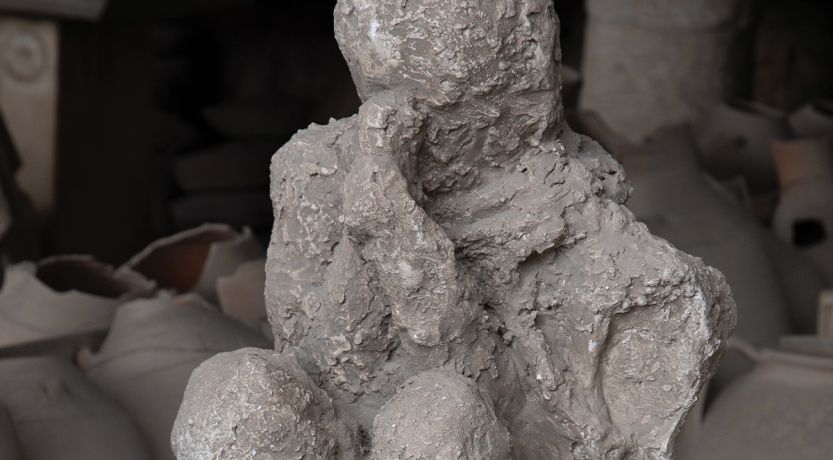Excavations at the site of one of the best-known disasters continue to amaze tourists and provide insights into the past. Is there a future for the victims?
I recently toured the Pompeii Archaeological Park near Naples in the Campania region of Italy. The ancient Roman city was buried by around 20 feet of pumice and ash from the eruption of Mount Vesuvius in A.D. 79.
Designated a UNESCO World Heritage Site because it is the only archaeological site providing a complete snapshot of an ancient Roman city, Pompeii is one of Italy’s most popular tourist attractions.
The tour began with a quick overview of the devastating natural disaster. Over two days in either late August or late October (accounts vary), Mount Vesuvius, located only 5 miles away, spewed so much pumice and ash that all life in Pompeii ended. As bodies decayed within the ash, molds were created of humans in their final moments. So far, archaeologists have unearthed 1,150 bodies.
As we entered the park, the first exhibit was a structure housing plaster casts of some of these victims. While ancient streets, sewers, beautiful houses, frescos, bakeries, brothels, public baths, political signage and graffiti have been meticulously studied, the fate of these largely non-Christian people is hardly ever addressed.
Is there hope for the victims who died in Pompeii?
Common views of life after death
Beliefs about what happens after death vary. Atheists believe that this life is all there is—that there is no afterlife. Some people believe in reincarnation, where a person may be reborn multiple times before entering another world.
Archaeologists made casts from the molds left by bodies buried by the pumice and ash at Pompeii (photos by David Treybig).
Most claiming to be Christian believe that humans possess an immortal soul that remains conscious after death, going either to heaven to be with God or to hell to suffer for eternity. Since the Bible teaches that Jesus’ name is the only one “by which we must be saved,” the widely held assumption is that the two-thirds of the world’s population that is not Christian will go to hell (Acts 4:12).
If this common belief were true, there wouldn’t be much hope for most of humanity, including the non-Christian victims of Pompeii.
In this article let’s consider what God’s Word says about the soul and life after death. When properly understood, this instruction is quite encouraging.
What is a soul?
Before we can focus on the fate of people who have died without acknowledging Jesus as their Savior, we must understand what the soul is.
After God fashioned Adam from the dust of the ground and breathed into him the breath of life, “man became a living being [soul, King James Version]” (Genesis 2:7). The Hebrew word translated “being” and “soul” is nephesh, meaning “soul, self, life, creature, person, appetite, mind, living being, desire, emotion, passion” (Brown-Driver-Briggs Hebrew Definitions).
The fact that Adam became a living soul invites the question of whether there can be dead souls—beings that are no longer alive. The Bible definitively answers this question. Adam was told that if he disobeyed God by eating the fruit of the tree of the knowledge of good and evil he would “surely die” (Genesis 2:17).
This foundational truth about the soul was repeated by Ezekiel, who wrote, “The soul who sins shall die” (Ezekiel 18:4, 20).
The mistaken belief that humans have an immortal soul that will not die was introduced to humanity by Satan who said to Eve, “You will not surely die” (Genesis 3:4).
This false teaching was perpetuated by pagan cultures and honed by Greek philosophers. For further explanation, see our articles “Do Humans Have an Immortal Soul?” and “Lessons From the First Lie.”
Resurrection: how humans can live again
While humans do not have immortal souls, the Bible teaches that mortal people who die can live again. Coming back to life after being dead is called resurrection. This is the hope each of us can have for life after death.
Isaiah understood this process. In speaking to God, he said: “Your dead shall live; together with my dead body they shall arise. Awake and sing, you who dwell in dust; for your dew is like the dew of herbs, and the earth shall cast out the dead” (Isaiah 26:19).
Cooking area with pans from ancient Pompeii.
Resurrection from the grave does not happen immediately after someone is buried. Prior to his death, Job addressed this, saying, “If a man dies, shall he live again? All the days of my hard service I will wait, till my change comes. You shall call, and I will answer You” (Job 14:14-15).
Resurrections from the grave will begin when Jesus returns to rule the earth. As 1 Thessalonians 4:16 explains, “For the Lord Himself will descend from heaven with a shout, with the voice of an archangel, and with the trumpet of God. And the dead in Christ will rise first.”
Jesus confirmed the certainty of this teaching when He said, “Do not marvel at this; for the hour is coming in which all who are in the graves will hear His voice and come forth—those who have done good, to the resurrection of life, and those who have done evil, to the resurrection of condemnation” (John 5:28-29). The Greek word translated “condemnation” is krisis, which can mean “judging” (see our blog post “All Who Are in the Graves Will Hear His Voice”).
The order of the resurrections
In 1 Corinthians 15, often referred to as the Resurrection Chapter of the Bible, Paul explained this process of coming back to life.
He noted that “Christ is risen from the dead, and has become the firstfruits of those who have fallen asleep. For since by man came death, by Man also came the resurrection of the dead. For as in Adam all die, even so in Christ all shall be made alive. But each one in his own order: Christ the firstfruits, afterward those who are Christ’s at His coming” (verses 20-23, emphasis added).
Paul describes the resurrections as beginning with Christ and continuing with “those who are Christ’s at His coming.” As noted earlier, Paul stated that the dead in Christ would “rise first” (1 Thessalonians 4:16). This raises another question: Are there other resurrections that occur after these faithful Christians are brought back to life?
The simple answer is yes! People who did not know about or understand Jesus’ teaching will also be resurrected.
In the book of Revelation, John writes that the saints—God’s faithful people through the ages—will be resurrected as immortal spirit beings and rule in the Kingdom of God under Jesus Christ on earth for 1,000 years. These people rise in “the first resurrection” (Revelation 20:5-6).
Revelation 20:5 also explains, “But the rest of the dead did not live again until the thousand years were finished.” This will be the time when non-Christians, including the victims of Pompeii, will be brought back to life.
Since this passage speaks of a “first resurrection,” it is logical to refer to this subsequent one as the second resurrection.
The second resurrection
What will the world be like when the victims of Pompeii are resurrected? What types of bodies will they have? Will they have the opportunity to learn about God and receive the same blessings as those in the first resurrection?
Floor mosaics found in Pompeii.
The answers to these questions are found in the writings of the Old Testament prophets and in the words of Jesus Himself during His earthly ministry.
Through the prophet Ezekiel, we see an example of ancient Israelites—who are representative of all peoples—coming back to physical life to have an opportunity to respond to God with the help of God’s Holy Spirit (Ezekiel 37:1-14). Additionally, it will be easier for them to obey because Satan will have been removed (Revelation 20:10).
Jesus also spoke of this future time, stating that people who had been dead for hundreds or even thousands of years would live again and be judged alongside people alive during His time. He specifically mentioned the ancient peoples of Sodom, Gomorrah, Tyre, Sidon, Nineveh and the queen of the South (Matthew 10:15; 11:22-24; 12:41-42).
These people represent the vast majority of humanity through the ages—people who have not known God and His expectations. But the God “who desires all men to be saved and to come to the knowledge of the truth” will give these individuals their first real opportunity to understand and live the way of life that leads to eternal life (1 Timothy 2:4).
This time of opportunity, the Great White Throne Judgment of Revelation 20:11, is pictured by one of God’s annual holy days—the Eighth Day (Leviticus 23:39). It will be a time of spiritual education, concluding with these people being judged by God’s laws as found in the Bible (Revelation 20:12). It will be their first opportunity to truly know God and receive the blessings He pours out on those who respond to Him.
This is the opportunity that lies ahead for the deceased people of Pompeii and for the rest of mankind who lived and died and never knew of or recognized Jesus Christ as their Savior.
For further study, see “What Are the Resurrections?” and From Holidays to Holy Days.
Sidebar: Excavations in Pompeii
When Mount Vesuvius erupted in A.D. 79, the city of Pompeii was buried under approximately 20 feet of pumice and ash. For centuries, it lay relatively undisturbed until digging began in 1748. In time an inscription was found verifying the site to be Pompeii.
Early excavation work was marred by the undisciplined activity of treasure seekers and untrained workers. In 1860 Italian archaeologist Giuseppe Fiorelli became the director of the excavations. He brought order to the process by carefully documenting what had been uncovered and by dividing Pompeii into nine regions. Insulae (blocks) in each region were numbered and each door on the street was given a number.
Fiorelli also developed a process for making casts from the molds left by decomposed human bodies.
Wall frescoes uncovered in Pompeii.
At the Archaeology Park of Pompeii the casts of the victims are “usually positioned for viewing, in showcases or sheltered by canopies, where the bodies had been originally found. The Garden of the Fugitives was so-called on account of the presence of thirteen of these bodies all still in their original locations. The casts have even been a source of inspiration for poets and artists, such as Primo Levi, author of the poem ‘The Girl-Child of Pompeii,’ and Roberto Rossellini, who set a scene of his film ‘Journey to Italy’ (showing the discovery of some casts) in Pompeii” (PompeiiSites.org).
Although the work paused during WWII, it resumed thereafter, and by 1990 about two-thirds of Pompeii had been excavated. Among the discoveries were public buildings, temples of pagan deities, bakeries, a public bath, a laundry, fast-food shops, a brothel and luxurious houses replete with floor mosaics, wall frescoes and private gardens.
Signage included political messages, street markers for a brothel and graffiti. Interestingly, the graffiti is particularly prized, as it provides rare examples of Vulgar Latin as opposed to the Latin of classical writers.
Recently, a new round of exploration began. In January 2024, excavated sites in Regio IX, one of nine neighborhoods, were made accessible to the public. Some of the finds include beautiful frescoes, a large banquet hall with black walls and a mosaic floor, and a blue room believed to have been a sacrarium, a place devoted to ritual activities and the storage of sacred objects.
Visiting Pompeii and seeing the casts of some of the people whose lives were snuffed out in a moment sparks sobering questions addressed in this article.






